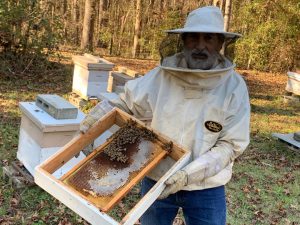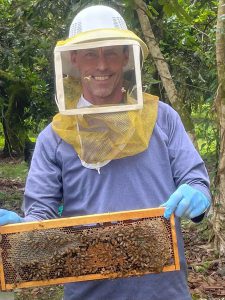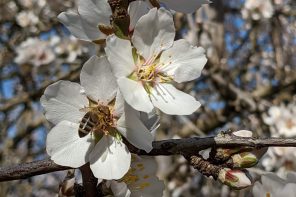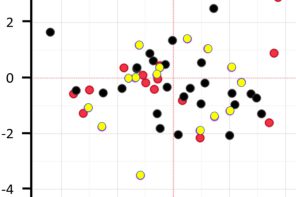Raising Queens Doesn’t Have to be Daunting if You Use the Hopkins Method
By: Joe Conti
I “blame” editor Jerry Hayes for getting me started in writing about the Hopkins Method for raising queens. As it happened, some years ago I was looking at some information regarding raising queens and found some references to American Bee Journal articles written by Jerry in 1984 and 1991, espousing a simple method for making queens in the privacy of your own beeyard! With my curiosity piqued, it was time to read more about it, which eventually led to my actually using it. This article is the third publication I’ve done on it, and a detailed description of the method can be found in the booklet The Hopkins Method For Raising Queens In Your Small Apiary (Conti, 2021; Northern Bee Books, West Yorkshire, UK) and the original article Need A Queen? Try The Hopkins Method (Conti, 2021; American Bee Journal 161:551-553). However, in two upcoming issues of Bee Culture, I hope to bring this technique to light once more, and with some updated tips.
The Hopkins Method was named after New Zealand’s Chief Apiarist Isaac Hopkins who described it in 1911 (Hopkins, 1911). While Hopkins gave credit to an Austrian beekeeper who first tried and described it, no name was provided. Some in the U.S. refer to it as the Case method after a 1912 oral presentation by H.L. Case in New York, but it was Hopkins who experimented with it and reported his results in writing.
If you’ve read this far, you must have an interest in raising some queens. So why might the Hopkins Method be of importance to you? Well, if you find yourself trying to keep beekeeping costs down, and current queen-rearing methods leave you a bit overwhelmed, maybe consider this alternative method that gets very little attention. You might find it to be cheaper, easier to do and possibly more beneficial.
Here’s a typical scenario a beekeeper with a few years experience might find themselves in. Spring arrives, and you are interested in supplying your small but growing apiary (10-20 colonies) with an influx of young queens, knowing that this could result in vigorous colonies. Should you buy from breeders at $30 a queen? If so, you will incur costs anywhere from $300-$600 depending on the number of colonies. On top of costs, there are some inherent risks involved with ordering queens that involve the shipping of queens, success of queen introduction and quality of your new queens.
Or maybe you’ve seen in bee journals and catalogs all the interesting and diverse contraptions you can buy to produce your own queens involving the technique of grafting. This is the moving of young larvae from cells into ‘queen cups’ for the developing queens. It is a technique that commercial queen breeders rely on heavily, and is available for small scale beekeepers. However, after looking at the equipment necessary to do this, such as grafting needles, cell bars, cell cups and cell protectors, in addition to costs and the required expertise, it appears that making your own queens is not necessarily an easy task.

Figure 1. Here I am holding a shim with a horizontal frame suspended in it, the basic setup for doing the Hopkins Method for raising queens. Part 2: the step-by-step procedure
Are there other ways to raise queens without the costs of either buying them outright, or buying the grafting equipment and learning the delicate grafting technique? Well, the easiest and cheapest way to produce more queens is to remove your current queens, and let each colony re-queen themselves. This is a perfectly viable method (aside from time lost in all your colonies while new queens are being made). But perhaps you noticed about half of your colonies were very weak coming out of Winter, and really only a few were considered “really good” to raise queens from; and maybe letting the weaker colonies raise their own queens is not necessarily the best idea. The thought occurred that you could remove frames of eggs from your strong colony(ies) and place them in the weaker colonies, but this comes at the expense of the strong colonies. So how could you preserve and use the genetics from strong colonies without affecting them? Enter the Hopkins Method. It allows you to produce your own queens with practically no budget. The basic premise is to pick your strongest colony (best queen in terms of size, laying abilities, gentleness and hygienic traits of her offspring) and remove just a single frame of eggs that another colony will raise queens from. It is done with a shim modified to hold this frame… in a horizontal position (Figure 1).
In part 2, I will describe the actual technique with tips along the way. Part 3 will focus on why the technique can be valuable for beekeepers, and how beekeepers can increase the quality of the drones that are mating with your new superior queens. Tune in!
Conti, J.A. 2021. Need A Queen? Try The Hopkins Method. Amer Bee J 161:551-553.
Conti, J.A. 2021. The Hopkins Method For Raising Queens In Your Small Apiary. Northern Bee Books, West Yorkshire, UK. 38pp.
Hopkins, L. 1911. Australasian Bee Manual. Another Method Of Raising Cells. Wellington, New Zealand: Gordon and Gotch Ltd. 173pp.









